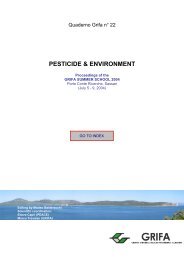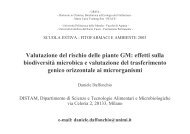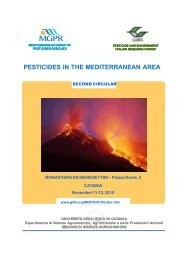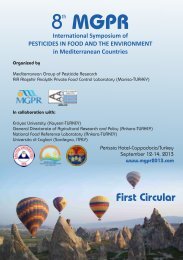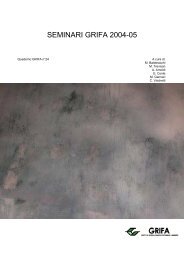International Congress BIOLOGICAL PRODUCTS - Gruppo di ...
International Congress BIOLOGICAL PRODUCTS - Gruppo di ...
International Congress BIOLOGICAL PRODUCTS - Gruppo di ...
Create successful ePaper yourself
Turn your PDF publications into a flip-book with our unique Google optimized e-Paper software.
TOXICITY AND ANALYSIS OF MYCOTOXINS AND THEIR OCCURRENCE IN SOME ORGANIC<br />
<strong>PRODUCTS</strong><br />
M. Solfrizzo, M. Pascale, A. Visconti, G. Avantaggiato<br />
CNR, Institute of Science of Food Production, Viale Einau<strong>di</strong> 51, 70125 Bari, I taly<br />
Fumonisins, ochratoxin A, and deoxynivalenol are among the most important mycotoxins due to their toxicity and<br />
frequent occurrence in foodstuffs, inclu<strong>di</strong>ng cereals. Fumonisins are mainly produced by Fusarium verticillioides e F.<br />
proliferatum on maize before and soon after harvest. These toxins can cause equine leukoencephalomalacia, porcine<br />
pulmonary oedema, liver and kidney cancer in rodents, nephrotoxicity and immunosuppression. The occurrence of<br />
ochratoxin A in cereals depends on geographic areas and is related to the presence of Penicillium verrucosum and<br />
Aspergillus ochraceus. Ochratoxin A has a strong nephrotoxicity and, at higher dosage, is carcinogenic on renal<br />
proximal tubule. Deoxynivalenol occurs in wheat, barley, oats, rye, spelt and maize and less frequently in rice,<br />
sorghum, and triticale. It is produced by F. graminearum e F. culmorum two important plant pathogens. Recent<br />
toxicological evaluation by Joint FAO/WHO Expert Committee on Food Ad<strong>di</strong>tives have established provisional<br />
maximum tolerable daily intakes of 2 e 1 µg/kg of body weight for fumonisins and deoxynivalenol, respectively. The<br />
provisional tolerable weekly intake of ochratoxin A of 0.1 µg/kg of body weight has been confirmed.<br />
For the analysis of cereal based food aimed to assess mycotoxin intake the use of validated analytical methods is<br />
essential. At this regard the European Committee for Standar<strong>di</strong>zation (CEN) has established method acceptability<br />
criteria for each mycotoxin. Recently, we have developed and validated by a collaborative study a new HPLC method<br />
for the determination of fumonisins in maize and maize based foods which has been adopted by CEN as European<br />
Standard Method. Official standard methods based on HPLC are available for the analysis of ochratoxin A in cereals,<br />
whereas a suitable method that respond to CEN criteria needs to be produced for deoxynivalenol.<br />
The consumption of organic products in Europe has increased in the last years but few information are available on their<br />
mycotoxin contamination as compared to conventional products. It is well known that agricultural practices play a role<br />
on mycotoxin formation in cereals.<br />
A total of 461 cereal samples collected in Italy, inclu<strong>di</strong>ng 186 samples originating from organic production (136 soft<br />
wheat and 50 spelt) harvested in 1998-2000 and 275 samples from conventional production (138 soft wheat and 137<br />
durum wheat) harvested in 1999-2000 have been analysed for deoxynivalenol in our laboratory. A higher incidence of<br />
positive samples was found in organic wheat (65-100% of positive samples) and organic spelt (100% of positive<br />
samples) as compared to conventional wheat (38-80% of positive samples), whereas the highest levels of<br />
deoxynivalenol were found in conventional wheat (up to 6465 µg/kg). In particular, mean levels of deoxynivalenol in<br />
positive samples of organic soft wheat, organic spelt, conventional soft wheat and conventional durum wheat were 70-<br />
180 µg/kg, 148-192 µg/kg, 219-604 µg/kg e 251-1097 µg/kg, respectively.<br />
PDF creato con FinePrint pdfFactory versione <strong>di</strong>mostrativa http://www.secom.re.it/fineprint<br />
20



